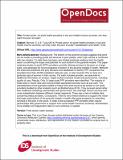| dc.contributor.author | Bennett, Sara | |
| dc.contributor.author | Tung, Elizabeth | |
| dc.date.accessioned | 2014-07-14T09:45:58Z | |
| dc.date.available | 2014-07-14T09:45:58Z | |
| dc.date.issued | 2014-06-24 | |
| dc.identifier.citation | Bennett, S. & E. Tung (2014) Private sector, for-profit health providers in low and middle income countries: can they reach the poor at scale? Globalization and Health 10:52. | en_GB |
| dc.identifier.issn | 1744-8603 | |
| dc.identifier.uri | https://opendocs.ids.ac.uk/opendocs/handle/20.500.12413/4194 | |
| dc.description.abstract | Background
The bottom of the pyramid concept suggests that profit can be made in providing goods and services to poor people, when high volume is combined with low margins. To-date there has been very limited empirical evidence from the health sector concerning the scope and potential for such bottom of the pyramid models. This paper analyzes private for-profit (PFP) providers currently offering services to the poor on a large scale, and assesses the future prospects of bottom of the pyramid models in health.
Methods
We searched published and grey literature and databases to identify PFP companies that provided more than 40,000 outpatient visits per year, or who covered 15% or more of a particular type of service in their country. For each included provider, we searched for additional information on location, target market, business model and performance, including quality of care.
Results
Only 10 large scale PFP providers were identified. The majority of these were in South Asia and most provided specialized services such as eye care. The characteristics of the business models of these firms were found to be similar to non-profit providers studied by other analysts (such as Bhattacharya 2010). They pursued social rather than traditional marketing, partnerships with government, low cost/high volume services and cross-subsidization between different market segments. There was a lack of reliable data concerning these providers.
Conclusions
There is very limited evidence to support the notion that large scale bottom of the pyramid models in health offer good prospects for extending services to the poor in the future. In order to be successful PFP providers often require partnerships with government or support from social health insurance schemes. Nonetheless, more reliable and independent data on such schemes is needed. | en_GB |
| dc.description.sponsorship | UKaid | en_GB |
| dc.language.iso | en | en_GB |
| dc.publisher | Springer | en_GB |
| dc.rights.uri | http://creativecommons.org/licenses/by/3.0/ | en_GB |
| dc.subject | Economic Development | en_GB |
| dc.subject | Finance | en_GB |
| dc.subject | Health | en_GB |
| dc.subject | Poverty | en_GB |
| dc.subject | Rural Development | en_GB |
| dc.title | Private sector, for-profit health providers in low and middle income countries: can they reach the poor at scale? | en_GB |
| dc.type | Article | en_GB |
| dc.rights.holder | The authors | en_GB |
| dc.identifier.externaluri | http://www.globalizationandhealth.com/content/10/1/52 | en_GB |


